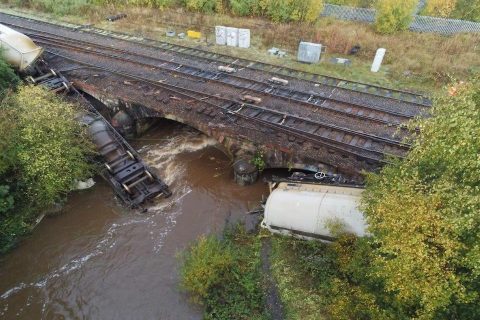
Carlisle derailment: investigators waste no time
Thursday night’s (20 October) freight derailment in Cumbria will have lasting effects on goods and passenger services south from the city of Carlisle for weeks to come. However, the inspectors on-site have only taken days to produce their interim report, pointing the finger of blame at a jammed wheelset, which brought a heavy cement train to grief at Petteril Bridge Junction in the southeast of Carlisle.
Moving quickly, the Rail Accident Investigation Branch, the official safety watchdog, has published early findings into Thursday’s crash. A false flange, ground out by a defective set of brakes, seems to have been the cause of the calamitous derailment, which is set to disrupt the Tyne Valley line and Settle and Carlisle route for weeks to come. Both lines are important freight routes. The spectacular Settle and Carlisle route is also a vital parallel route for the West Coast Main Line, providing a route for heavy bulk traffic and relieving the busy mixed-traffic route.
Fully loaded train and extensive damage
As revealed by RailFreight.com, the Thursday night accident involved the scheduled working from Clitheroe in Lancashire, due off at 17:15hrs, and heading for Carlisle Yard. “At about 20:03hrs on [Thursday] 19 October 2022, the 17:15hrs Clitheroe to Carlisle Yard freight service derailed at Petteril Bridge Junction, near Carlisle”, said a statement from the RAIB.
The train, weighing in at around 1500 tonnes, ploughed up track and infrastructure on both the Carlisle and Settle and Tyne Valley routes. Extensive damage was also inflicted on the bridge that carries the rails over the River Petteril. “The freight train involved was formed of a Class 66 locomotive and 14 loaded cement wagons. Five of these wagons derailed. One of the derailed wagons subsequently entered the River Petteril”, said an understated line from the RAIB.
Recovery to take weeks rather than days
The infrastructure agency Network Rail is working with the Rail Accident Investigation Branch to determine how several wagons left the track and came to rest on an embankment and in the River Petteril. Railway engineers have carried out an initial scope of damage to tracks, a railway bridge and line-side equipment. Making those repairs, combined with the challenge of recovering the train’s wagons, is estimated to take weeks rather than days. No one was injured in the incident, but the railway will remain closed in both directions for some time.

Network Rail reiterated that there will be a major disruption for all rail services between Carlisle, Newcastle and Appleby and Skipton. “On the rare occasions trains leave tracks like this, it can cause extensive damage, and unfortunately, this incident is no exception”, said Phil James, Network Rail’s North West route director. “I understand this will be extremely frustrating on this crucial rail link from east to west linking Carlisle and Newcastle, as well as south to Skipton. Across the rail industry, we’re working as fast as we can to restore the railway for passengers and freight.”
False flanges blamed
Spectacular pictures soon emerged of the distressed train, with rolling stock upturned and track buckled beyond repair. Mercifully, there were no injuries were caused by the accident, which led to substantial damage to railway infrastructure and some of the vehicles involved. RAIB say the lines from Newcastle to Carlisle were blocked as a result of the accident. The scenes are reminiscent of the Llangennech derailment in Wales in early 2021, when an oil train derailed over points due to a defective wheelset.
Currently, available evidence indicates that the derailment was almost certainly a result of a wheelset with false flanges encountering a set of switches that are part of the junction, said the RAIB. “False flanges are associated with the flat areas on wheel treads which can result when rail wheels stop rotating while a vehicle is running”, they said. “Our investigation will seek to identify the sequence of events which led to the accident. It will include consideration of track conditions, the condition of the wagons, wagon characteristics, the status of the train’s braking systems and any underlying management factors”, they added in their standard response.
You just read one of our premium articles free of charge
Want full access? Take advantage of our exclusive offer




